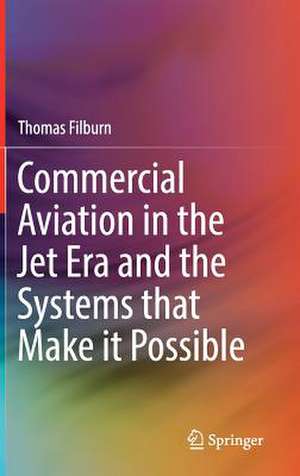Commercial Aviation in the Jet Era and the Systems that Make it Possible
Autor Thomas Filburnen Limba Engleză Hardback – 5 aug 2019
| Toate formatele și edițiile | Preț | Express |
|---|---|---|
| Paperback (1) | 248.05 lei 3-5 săpt. | |
| Springer International Publishing – 14 aug 2020 | 248.05 lei 3-5 săpt. | |
| Hardback (1) | 256.41 lei 3-5 săpt. | +36.98 lei 5-11 zile |
| Springer International Publishing – 5 aug 2019 | 256.41 lei 3-5 săpt. | +36.98 lei 5-11 zile |
Preț: 256.41 lei
Nou
Puncte Express: 385
Preț estimativ în valută:
49.07€ • 51.04$ • 40.51£
49.07€ • 51.04$ • 40.51£
Carte disponibilă
Livrare economică 24 martie-07 aprilie
Livrare express 08-14 martie pentru 46.97 lei
Preluare comenzi: 021 569.72.76
Specificații
ISBN-13: 9783030201104
ISBN-10: 3030201104
Pagini: 224
Ilustrații: XVI, 203 p. 99 illus., 71 illus. in color.
Dimensiuni: 155 x 235 x 23 mm
Greutate: 0.49 kg
Ediția:1st ed. 2020
Editura: Springer International Publishing
Colecția Springer
Locul publicării:Cham, Switzerland
ISBN-10: 3030201104
Pagini: 224
Ilustrații: XVI, 203 p. 99 illus., 71 illus. in color.
Dimensiuni: 155 x 235 x 23 mm
Greutate: 0.49 kg
Ediția:1st ed. 2020
Editura: Springer International Publishing
Colecția Springer
Locul publicării:Cham, Switzerland
Cuprins
Commercial Aviation history.- Flight Controls, High lift systems and their actuation.- Engines and Nacelles.- Cabin Pressurization and Air Conditioning.- Wheels, Brakes and Landing Gear.- Fuel Systems.- Instruments and sensors.- Anti-ice and Deice systems for wings, nacelles, and instruments.- Loss of flight controls, United Flight 232.- In Flight Thrust Reverse Actuation.- Cabin Pressurization Accident.- Landing Gear Accident.- Fuel System Failure.- Flight System Sensor Failure.- Icing Conditions.- Conclusion.- Index.
Notă biografică
Thomas Filburn is Project Liaison in the Materials and Processes Engineering group at Pratt &Whitney Aircraft. Previously he was Director of Research, UTAS Program Office, United Technologies Research Center, in East Hartford, Connecticut. He obtained his Ph.D. from the University of Connecticut in Chemical Engineering; he also holds a B.Sc. and M.S. in Mechanical Engineering from the University of Connecticut, Storrs CT. He has worked for Northeast Utilities, United Nuclear Corporation and United Technologies Corporation (UTC). Prior to joining the faculty at the University of Hartford he performed research for a liquid metal combustion system used for torpedo propulsion at the Applied Research Lab at Penn State University. His last assignment before joining the University was with the Space, Land and Sea group at Hamilton Sundstrand (UTC division), where he performed research on regenerative life support technologies for NASA. His research interests lie inthe area of energy, sustainable design, greenhouse gas control and environmental design. He has published in Industrial and Engineering Chemical Research, the Fuels Journal of the American Chemical Society and has presented at many conferences. He holds 8 US patents for a variety of aerospace applications.
Textul de pe ultima copertă
This book discusses the multiple systems that make commercial jet travel safe and convenient. The author starts by tracing the evolution of commercial jets from the Boeing 707 to the double decker Airbus A380. The next 7 chapters discuss flight controls, along with the high lift surfaces (flaps and slats) that are essential to allow high speed, low drag aircraft to take-off and land. The other systems include Engines/Nacelles, Cabin Pressurization and Air Conditioning systems, Landing Gear and brakes, Fuel Systems, Instruments/Sensors, and finally Deicing systems for the wings, nacelles and external air speed sensors. Case studies describe a significant accident that arose from a failure in the various systems described. The final chapter summarizes the past 60 years of jet travel and describe how these systems have created a cheaper, safer mode of travel than any other.
- Discusses the “behind the scenes” systems that keep commercial aircraft operating todesigned specification, including materials of construction, nominal as well as severe requirements, normal, off-normal and emergency operation;
- Describes the high loads and large movements necessary to reconfigure an airplane from low-drag, Mach 0.87 flight to high lift low speed take-off and landing speeds;
- Explains the importance and operation of the various, aviation sub-systems by describing what happens when failures occur in this equipment.
Caracteristici
Discusses the “behind the scenes” systems that keep commercial aircraft operating to designed specification, including materials of construction, nominal as well as severe requirements, normal, off-normal and emergency operation Describes the high loads and large movements necessary to reconfigure an airplane from low-drag, Mach 0.87 flight to high lift low speed take-off and landing speeds Explains the importance and operation of the various, aviation sub-systems by describing what happens when failures occur in this equipment
